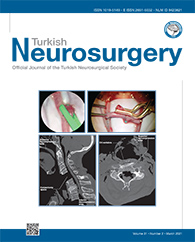2Clinical Medical College of Yangzhou University, Department of Neurosurgery, Yangzhou, China DOI : 10.5137/1019-5149.JTN.31405-20.2 AIM: To evaluate the clinical outcomes of incidental meningiomas (IM) treated with stereotactic radiosurgery (SRS) or observation.
MATERIAL and METHODS: The PubMed, Cochrane Library and MEDLINE (Ovid) databases were comprehensively searched for eligible studies about IM that were managed with serial imaging follow-up or SRS. We performed a systematic review and metaanalysis of the tumor progression rate between these two groups. The SRS-related morbidity was qualitatively analyzed. To predict potential tumor growth, the correlation between rapid tumor growth and the following factors, MRI T2 hyperintensity, initial tumor diameter and age were also analyzed by meta-analysis.
RESULTS: Sixteen studies were included. The SRS treatment group had significantly higher tumor control than the observation group in a mean follow-up of more than 3 years (pooled OR: 0.06, 95% CI: 0.01-0.20, p<0.0001; random effects model). Additionally, there was an acceptable level of SRS-associated morbidity. Tumor progression was positively associated with MRI T2 hyperintensity (pooled OR: 1.93, 95% CI: 1.30-2.87, p<0.05, fixed effects model), initial large tumor diameter (pooled OR: 3.19, 95% CI: 0.94- 5.44, p<0.05, fixed effects model) and younger age to some extent (pooled OR: -3.80, 95% CI: -9.13-1.53, p>0.05, random effects model). Absence of calcification was consistently shown to be a risk factor for progressive IM based on the existing literature.
CONCLUSION: SRS is a rational treatment for incidental meningioma in consideration of the higher tumor control rate and acceptable complications compared with treatment via observation. The integration of risk factors such as absence of calcification, MRI T2 hyperintensity and initial large tumor size may contribute to accurately predicting rapid tumor growth.
Keywords : Incidental meningioma, Observation, Stereotactic Radiosurgery




